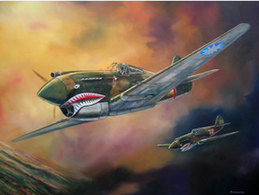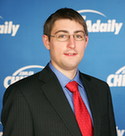進(jìn)入英語(yǔ)學(xué)習(xí)論壇下載音頻 去聽(tīng)寫(xiě)專區(qū)一展身手
HALF MOON BAY, California: As a young child, Michael Bianco grew up with stories of his uncle's time in East Asia during World War II. As one of the first airmen in the China-Burma-India (CBI) Theater during the war, Major S. Thomas Bianco was a part of the "Flying Tigers," a WWII unit that played a critical role in fending off Japanese military strikes in China, especially in the initial days following the attack on Pearl Harbor in December 1941.
Nearly 70 years later, Bianco and a group of like-minded WWII and aviation enthusiasts gathered at Half Moon Bay Airport on December 21, the site where the first Flying Tigers initially took flight, to formally announce the launch of the Flying Tiger Heritage Park near Guilin, China.

The Flying Tigers, or "Fei Hu" in Chinese, was the name of the first American Volunteer Group (AVG) of the Chinese Air Force who originally earned their name from the shark designs on their plane noses. Under the direction of General Claire Chennault, the Flying Tigers achieved considerable recognition for their effectiveness in fighting Japanese aircraft with limited resources. Much of the unit's activities and strategic operations were concentrated in Lingui County which will be the site of the new park.
The park will be a joint development project between the Chinese government and the Flying Tiger Historical Organization, a US-based non-profit dedicated to preserving the story and contributions made by both China and the US in WWII. Once completed, the park will be part of a 300-acre resort that will include a museum, the Yang Tang airfield, and the original command cave used by General Chennault between 1941 and 1945.
"That field was virtually unchanged since 1945," said Larry Jobe, a retired United Airlines pilot who serves as the organization's president.
Jobe had originally come up with the idea with several other aviation and WWII enthusiasts during a 2006 tour of China, which included visits to several key aviation sites, including Changsha, Wuhan, and Guilin.
Among those present on the tour was retired two-star General James "Jim" Whitehead, who drew up the original proposal for the project. Realizing that China's economic development may soon reach the airstrip and cave which had largely been left alone for the last 64 years, General Whitehead agreed that something had to be done to preserve the site. He now serves as the organization's chairman of the board.
"It really hit me when someone said, 'It's a good thing you came this year because it wouldn't look like this next year,'" said Whitehead, who retired from the Air Force in 1993 after a 41-year military career.
With the help of Ma Kuan Chi (KC), who initially helped gain permission from local Chinese officials to visit many of these sites and now sits on the board of the directors, the Flying Tigers Historical Organization contacted local Chinese officials in Guilin to preserve the airstrip and cave as a historical site.
"There was a lot of support from every level of government from the municipal to the national level Guilin officials even took back land that had previously been allocated to individuals to help preserve the site," said Ma. While the organization had originally hoped to gain some basic support for the project from the Chinese government, no one had expected that it would grow into a multimillion dollar development that would include 300 acres instead of the originally proposed 15 acres.
"We had initially proposed that the Chinese would provide the architects, aqueducts, lands, and labor. At final approval, it had become a $23.4 million project over 300 acres - more than we had ever imagined," said General Whitehead. The Chinese government has agreed to raise and invest $23 million, and the Flying Tigers Historical Organization will be responsible for raising the remaining $400,000.
"This [$400,000] amount will go largely towards restoring the original command post where General Chennault first directed the Flying Tigers," said Bianco. He anticipates that the group will be able to raise this money over the next 12 to 18 months.
While only 100 pilots were part of the first AVG, media and local Chinese soon popularized the term and any US military pilot who served in China during WWII was considered to be a "Flying Tiger." In total, over 2,000 American pilots and support staff would pass through China between 1941 and 1945. Of the original 100, two are living today.
Although the story of the Flying Tigers has surfaced numerous times throughout the years, it has only been recently that notable official recognition has been given in China. Nonetheless, members of the organization noted how closely the story of the Flying Tigers resonated with many local Chinese individuals during their visits.
In a public radio interview in Wisconsin earlier this year, Jobe recalled how familiar the Flying Tiger story was in China compared to the United States today. Jobe and others in the Flying Tiger Historical Organization, however, hope that this will slowly change.
Questions:
1. Why did General Whitehead help draw up the proposal for the preservation of the airstrip and surrounding area?
2. Where does the name “Flying Tigers” come from?
3. What made the Flying Tigers famous?
Answers:
1. Realizing that China's economic development may soon reach the airstrip and cave which had been largely left alone for the last 64 years, General Whitehead agreed that something had to be done to preserve the site.
2. The Flying Tigers, or "Fei Hu" in Chinese, was the name of the first American Volunteer Group (AVG) of the Chinese Air Force who originally earned their name from the shark designs on their plane noses.
3. Under the direction of General Claire Chennault, the Flying Tigers achieved considerable recognition for their effectiveness in fighting Japanese aircraft with limited resources.
(中國(guó)日?qǐng)?bào)網(wǎng)英語(yǔ)點(diǎn)津 Helen 編輯)

About the broadcaster:

Dan Chinoy is a reporter and editor for the China Daily's website. A graduate of Columbia University, he grew up in Beijing, Hong Kong, and Taiwan. Dan has experience in Hillary Clinton's Senate Office in Washington, and Fortune Magazine in Beijing, the U.S. Consulate in Shenyang. Dan speaks Chinese, but not as well as he should.
